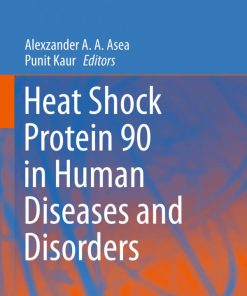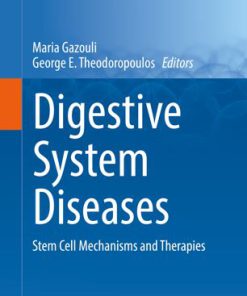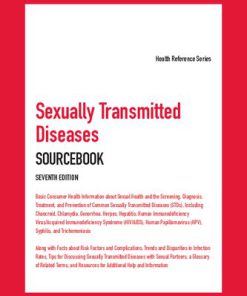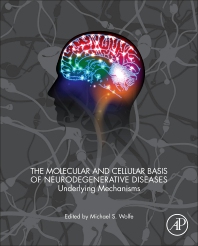Protein Homeostasis Diseases: Mechanisms and Novel Therapies 1st Edition by Angel Pey ISBN 0128191333 9780128191330
$50.00 Original price was: $50.00.$25.00Current price is: $25.00.
Protein Homeostasis Diseases: Mechanisms and Novel Therapies 1st Edition by Angel Pey – Ebook PDF Instant Download/Delivery: 0128191333, 978-0128191330
Full dowload Protein Homeostasis Diseases: Mechanisms and Novel Therapies 1st Edition after payment
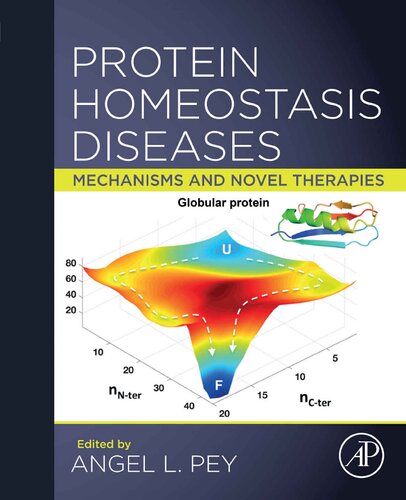
Product details:
ISBN 10: 0128191333
ISBN 13: 978-0128191330
Author: Angel L. Pey
Protein Homeostasis Diseases: Mechanisms and Novel Therapies offers an interdisciplinary examination of the fundamental aspects, biochemistry and molecular biology of protein homeostasis disease, including the use of natural and pharmacological small molecules to treat common and rare protein homeostasis disorders. Contributions from international experts discuss the biochemical and genetic components of protein homeostasis disorders, the mechanisms by which genetic variants may cause loss-of-function and gain-of-toxic-function, and how natural ligands can restore protein function and homeostasis in genetic diseases. Applied chapters provide guidance on employing high throughput sequencing and screening methodologies to develop pharmacological chaperones and repurpose approved drugs to treat protein homeostasis disorders.
- Provides an interdisciplinary examination of protein homeostasis disorders, with an emphasis on treatment strategies employing small natural and pharmacological ligands
- Offers applied approaches in employing high throughput sequencing and screening to develop pharmacological chaperones to treat protein homeostasis disease
- Gathers expertise from a range of international chapter authors who work across various biological methods and disease specific disciplines of relevance
Protein Homeostasis Diseases: Mechanisms and Novel Therapies 1st Table of contents:
Section I: Introduction of Protein Folding and Homeostasis
-
Chapter 1: Protein Folding – How, Why, and Beyond
- Abstract
- Abbreviations
- Introduction
- Acknowledgments
-
Chapter 2: Protein Homeostasis and Disease
- Abstract
- Abbreviations
- Protein Folding In Vitro and In Vivo
- Human Misfolding Diseases
- Acknowledgments
- Conflict of Interest
- Funding
Section II: Protein Folding and Homeostasis at the Organismal and Proteomic Scales
-
Chapter 3: Caenorhabditis elegans as a Model for Protein Homeostasis Diseases
- Abstract
- Abbreviations
- C. elegans as a Model Organism
- Conclusion
-
Chapter 4: Proteome-Scale Studies of Protein Stability
- Abstract
- Abbreviations
- Introduction
- Protein Stability and Unfolding
- Methods to Measure Protein Stability In Vitro and In Vivo
- Biological Readouts for Stability
- Structural and Proteome-Scale Analyses
- Applications to Biomedical Research
- Conclusions
- Acknowledgments
-
Chapter 5: Classifying Disease-Associated Variants by Protein Activity and Stability
- Abstract
- Abbreviations
- Introduction
- PTEN Variant Selection
- Comparing Assays and Predictions for Variant Effects
- Stability Loss and PTEN Function
- Conclusions
- Methods
- Acknowledgments
Section III: Disturbance in Protein Homeostasis in Disease – Genetics, Mechanisms, and Modulation by Natural Ligands
-
Chapter 6: Protein Destabilization and Degradation in Hereditary Disease
- Abstract
- Abbreviations
- Protein Quality Control in Hereditary Diseases
- Folding, Refolding, and Degradation Pathways
- Therapeutic Approaches
- Acknowledgments
- Conflict of Interest
- Funding
-
Chapter 7: Detection of Amyloid Aggregation in Living Systems
- Abstract
- Abbreviations
- Techniques for In Vivo Detection
- Animal Models for Testing
- Insights into Neurodegeneration
- Future Outlook
- Acknowledgments
-
Chapter 8: Molecular Mechanisms of Amyloid Aggregation in Human Proteinopathies
- Abstract
- Abbreviations
- Aggregates and Amyloid Fibrils
- Mechanisms and Disease Implications
- Concluding Remarks
- Acknowledgments
-
Chapter 9: Metals and Toxic Mechanisms in Neurodegenerative Diseases
- Abstract
- Abbreviations
- Metal Ions in Neurodegeneration
- Zinc and Alzheimer’s Disease Aggregates
- Metal Chelation Therapies
- Acknowledgments
-
Chapter 10: Vitamin B6-Dependent Enzymes and Disease
- Abstract
- Abbreviations
- Misfolding Diseases and Natural Ligands
- Vitamin B6 and Associated Disorders
- Hyperoxaluria and AGT Deficiency
- Conclusions
- Acknowledgments
-
Chapter 11: Galactosemia – Opportunities for Novel Therapies
- Abstract
- Abbreviations
- Types of Galactosemia
- Pathology, Treatment, and Novel Approaches
- Pharmacological Chaperones for GALT Deficiency
- Conclusions
- Acknowledgments
-
Chapter 12: Protein Homeostasis in GPCR Intracellular Trafficking
- Abstract
- Abbreviations
- Proteostasis in GPCR Trafficking
- Targeting Misfolded GPCRs with Chaperones
- Conclusions
- Acknowledgments
Section IV: Novel Small Molecules for Correcting Human Protein Diseases
-
Chapter 13: Structure-Guided Discovery of Pharmacological Chaperones
- Abstract
- Abbreviations
- Understanding Disease Variants Structurally
- Primary Screening for Chaperones
- Concluding Remarks
- Statements
- Acknowledgments
-
Chapter 14: Virtual Screening in Drug Discovery
- Abstract
- Abbreviations
- Drug Discovery Process
- Binding Affinity and Scoring Functions
- Screening Protocols for Receptor–Ligand Binding
-
Chapter 15: Differential Scanning Fluorimetry in Pharmacological Screening
- Abstract
- Abbreviations
- Background and High-Throughput Screening
- Conclusion
- Acknowledgments
-
Chapter 16: Cellular High-Throughput Screening
- Abstract
- Abbreviations
- Introduction to Screening Techniques
- Genetic Diseases and High-Throughput Screening
- Conclusion
- Acknowledgments
-
Chapter 17: High-Throughput Screening for Intrinsically Disordered Proteins
- Abstract
- Abbreviations
- Techniques: Fluorescence, NMR, SPR
- Applications for Identifying Potential Drug Hits
- Funding
-
Chapter 18: Chaperones in Protein Degradation and Erythropoietic Porphyria
- Abstract
- Abbreviations
- UROIIIS Stability Defects
- Congenital Erythropoietic Porphyria
People also search for Protein Homeostasis Diseases: Mechanisms and Novel Therapies 1st:
protein homeostasis and diseases
extracellular protein homeostasis in neurodegenerative diseases
protein homeostasis and neurodegenerative diseases
what is protein homeostasis
how does protein maintain homeostasis
You may also like…
Biology and other natural sciences
Heat Shock Protein 60 in Human Diseases and Disorders Alexzander A. A. Asea
Medicine
Drug Delivery Challenges and Novel Therapeutic Approaches for Retinal Diseases Christopher L. Cioffi
Biology and other natural sciences
Heat Shock Protein 90 in Human Diseases and Disorders Alexzander A. A. Asea
Medicine - Molecular Medicine
Medicine - Infectious diseases
Medicine - Infectious diseases
Sexually Transmitted Diseases Sourcebook 7th Edition Angela L. Williams
Biology and other natural sciences - Molecular
Protein Misfolding Diseases: Methods and Protocols Cláudio M. Gomes






